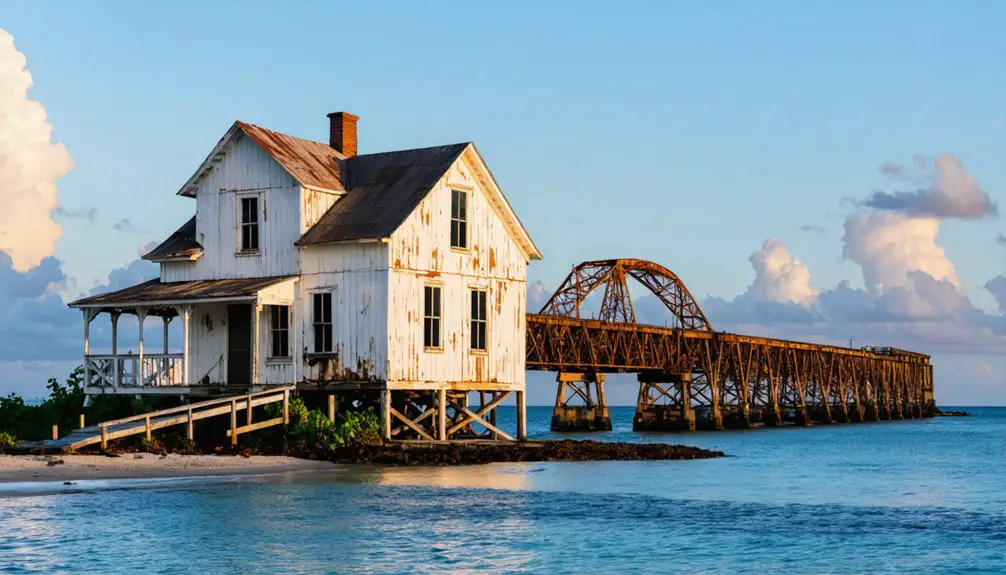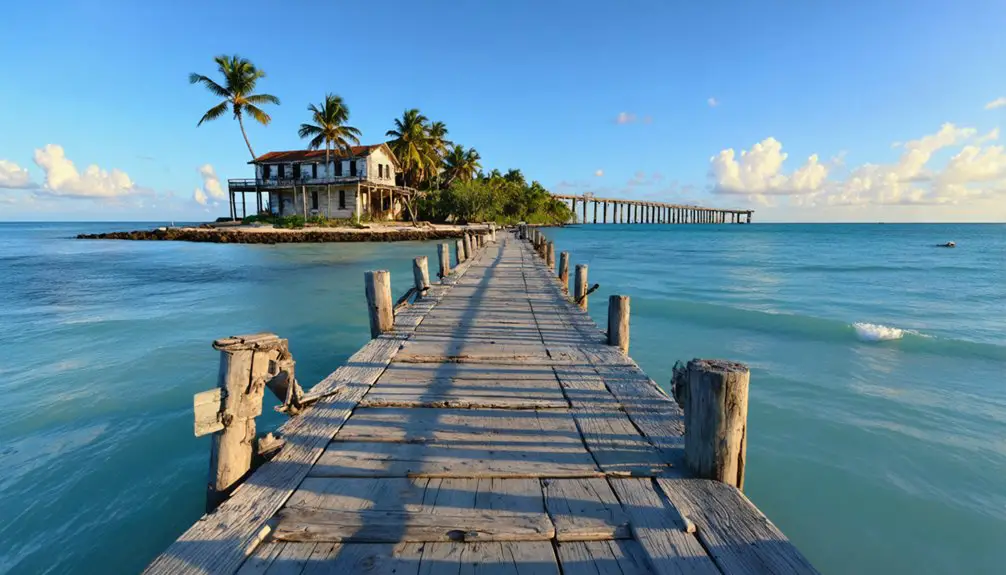You’ll find Pigeon Key, a historic five-acre island in Florida, where 400 railroad workers once lived during Henry Flagler’s Overseas Railroad construction in 1907. The self-contained community featured modern amenities like electricity, clean linens, and a dining hall, though workers endured tough conditions for $1.50 daily wages. After the devastating 1935 Labor Day Hurricane, the island transformed from a railway hub to a highway command center. Today’s preserved buildings and marine programs tell an even richer story.
Key Takeaways
- Pigeon Key is not a ghost town but a preserved historic site with eight buildings on the National Register of Historic Places.
- The island once housed 400 railroad workers during the Overseas Railroad construction in 1907, complete with modern amenities.
- After the 1935 Labor Day Hurricane destroyed much of the railroad infrastructure, the island transitioned from railway hub to highway center.
- The Pigeon Key Foundation maintains the site as a living museum, offering guided tours and educational programs about Florida’s railroad history.
- Original Flagler-era structures remain intact, including worker housing, commissary, and post office, preserving the early 1900s railroad camp atmosphere.
The Birth of a Railroad Worker’s Paradise
As railroad engineers surveyed the Florida Keys in 1907, they discovered Pigeon Key, a small but strategically positioned island that would become the heart of Henry Flagler’s ambitious Overseas Railroad project.
You’ll find that this 2-5 acre paradise wasn’t just chosen for its size – its central location along the Old Seven Mile Bridge route made it perfect for coordinating one of America’s greatest railroad innovations.
The island quickly transformed into a bustling community of 400 workers, featuring modern amenities that were rare for the era. Workers toiled through 10-hour workdays while earning $1.50 daily to bring Flagler’s vision to life.
You’d have found four well-maintained bunkhouses with clean linens, electricity, and laundry services. The railroad company generators supplied power to all facilities on the island.
The shallow waters surrounding Pigeon Key influenced unique engineering decisions, like the squared concrete piers, while the worker camaraderie flourished in reading rooms and community spaces that set new standards for construction camps.
Life During the Golden Age of Overseas Construction
Life on Pigeon Key during the railroad’s construction tested workers’ endurance with grueling 10-hour workdays, six days a week, for a mere $1.50 daily wage.
Workers endured punishing conditions on Pigeon Key, laboring sixty hours weekly for pocket change during the railroad’s ambitious construction.
You’d find yourself among 400 others on this tiny five-acre island, sharing cramped quarters and dining in a hall built for just 100 men. Worker camaraderie emerged despite the harsh conditions, as you’d face construction hardships together, driving iron pilings 28 feet underwater and placing massive steel girders.
Under Flagler’s strict Presbyterian rules, you wouldn’t find relief in alcohol after your shift.
Instead, you’d return to basic lodgings, surrounded by the constant hum of steam-powered machinery and the smell of coal. The isolated setting meant your world centered on the dining hall and living quarters, with little time for recreation between demanding shifts. The workers’ efforts ultimately led to the completion of the Seven Mile Bridge in 1909. The bridge would later be recognized for its historical significance when it was listed on the Register of Historic Places.
Nature’s Fury: The Great Labor Day Hurricane
When the Great Labor Day Hurricane slammed into the Florida Keys in 1935, it entered the record books as the most intense Atlantic hurricane ever recorded, with sustained winds reaching 185 mph and an unprecedented barometric pressure of 892 mb.
Without modern hurricane preparedness systems, communities had little warning as the storm rapidly intensified over 24 hours. Local authorities relied entirely on ship-to-shore reports to track the hurricane’s position.
The storm’s impact was catastrophic – an 18 to 20-foot surge swept across the Keys, destroying nearly every structure between Tavernier and Marathon. The Florida East Coast Railway’s infrastructure crumbled, and entire communities vanished. The town of Islamorada was obliterated by the hurricane’s destructive force.
You would’ve witnessed unimaginable devastation, with up to 485 confirmed deaths, including scores of WWI veterans working on the Overseas Highway.
The Russell family’s tragedy exemplified the human toll, losing 50 of 61 family members to nature’s fury.
From Railway Hub to Highway Milestone
You’ll find railroad workers’ daily life on Pigeon Key was grueling, with 400 laborers earning $1.50 for 10-hour workdays while enduring harsh conditions in cramped dormitories.
When you examine the island’s shift from rail to highway use after 1925, you’ll see how the original railway infrastructure adapted to serve a new purpose. The workers faced three major hurricanes during construction that severely impacted their progress and safety. The devastating Labor Day storm of 1935 brought winds over 200 mph that ravaged the Florida Keys.
The engineering evolution became most apparent as crews converted the Old Seven Mile Bridge’s railway tracks into highway guardrails, marking a practical transformation of Flagler’s original vision.
Railroad Workers’ Daily Life
During the peak construction period of the Overseas Railroad from 1908 to 1912, approximately 400 workers called Pigeon Key their temporary home.
You’d find them living in four bunkhouses, each designed to hold 64 men, with overflow workers staying in tents. Despite the harsh conditions, worker amenities were surprisingly modern for the time, including electric lighting powered by F.E.C. Railway generators – a rare luxury for remote islands. Located near Moser Channel, the deepest part of the Seven Mile Bridge, the island provided strategic positioning for the massive construction project.
Life centered around 12-hour shifts, with crews alternating day and night to maintain 24-hour construction.
While the work was grueling, community bonds formed naturally in the close quarters. You’d find clean bedding, weekly laundry service, and dedicated reading rooms. Most of the laborers were hobos from Northern cities seeking employment opportunities.
The island’s commissary, post office, and one-room school created a self-contained community, though under strict rules including Flagler’s no-alcohol policy.
Highway Era’s Engineering Evolution
The devastating Labor Day Hurricane of 1935 marked the end of Pigeon Key’s railroad era, destroying 40 miles of Henry Flagler’s Overseas Railroad track.
You’ll witness a remarkable transportation transformation as Florida’s government purchased the right-of-way for $640,000, launching an ambitious conversion project.
The engineering advancements that followed revolutionized travel to the Keys:
- Railroad tracks transformed into a 22-foot steel deck highway
- Original rails repurposed as protective guardrails
- Construction headquarters established on Pigeon Key
- Integration of water infrastructure within the modern bridge’s design
Preserving a Piece of Florida’s Railroad Heritage

You’ll find Pigeon Key’s historic buildings remarkably well-preserved, with original Flagler-era structures including dormitories, a mess hall, and various worker facilities still standing after more than a century.
The concrete bridge piers feature distinctive squared corners that set them apart from other Florida East Coast Railway structures, while the old railway tracks along Seven Mile Bridge now serve as safety railings for pedestrians and cyclists.
Through the dedicated efforts of the Pigeon Key Foundation, these architectural treasures continue to tell the story of Florida’s ambitious railroad expansion, offering visitors a tangible connection to the past through preserved buildings and educational programs.
Historic Buildings Stand Strong
Standing as proofs to Florida’s railroad heritage, Pigeon Key’s historic buildings have endured decades of harsh tropical weather and human activity.
When Hurricane Irma struck in 2017, it damaged the historic Honeymoon Cottage and Commissary, but through careful historic restoration, these structures now stand stronger than ever.
- Original materials like doors, windows, and flooring were salvaged to maintain authenticity
- Each building’s design matches its historical profile perfectly
- The 1913 Commissary and 1942 Honeymoon Cottage showcase period-specific architectural integrity
- Wood-frame construction allowed for unique mobility, reflecting the railway workers’ transient lifestyle
You’ll find eight recognized historic buildings on this small island, where up to 400 railroad workers once lived during the ambitious Overseas Railway construction from 1908 to 1912.
Railway Legacy Lives On
Despite no longer serving its original purpose as a bustling railroad construction base, Pigeon Key‘s rich railway heritage continues to captivate visitors through preserved structures and engineering marvels.
You’ll discover unique railroad engineering features like squared-corner concrete bridge piers, a departure from the rounded designs typical of other FEC Railway locations. The island’s shallow waters influenced innovative construction techniques that shaped the iconic Old Seven Mile Bridge.
When you explore the grounds today, you’ll find original buildings that once housed hundreds of workers during the ambitious 1907-1912 construction period.
After surviving the devastating 1935 hurricane, the island evolved from a railway hub into an Overseas Highway command center. Now preserved as a historic district, Pigeon Key stands as a symbol of Florida’s pioneering transportation achievements.
Modern Legacy as a Living Museum
While many historic sites struggle to maintain relevance, Pigeon Key has transformed into a vibrant living museum under the stewardship of the Pigeon Key Foundation.
Under the Foundation’s thoughtful guidance, Pigeon Key has evolved from a historic relic into an engaging, dynamic window into the past.
You’ll discover living history through interactive guided tours, maritime exhibits, and educational programs focused on both cultural heritage and marine science.
- Step back in time as you explore eight buildings listed on the National Register of Historic Places
- Experience the authentic atmosphere of a 1900s railroad work camp through preserved vernacular architecture
- Immerse yourself in the dramatic stories of the 1935 hurricane and WWII Coast Guard presence
- Connect with nature through fishing, snorkeling, and environmental stewardship programs
The educational impact extends beyond history, as the foundation actively combines heritage preservation with ecological awareness, ensuring this historic gem remains relevant for future generations.
Frequently Asked Questions
How Do Visitors Reach Pigeon Key Today Since the Old Bridge Bypass?
You’ll reach Pigeon Key via three options: walk/bike the restored Old Seven Mile Bridge during daylight hours, catch the visitor center’s tram service with scheduled tours, or arrange boat access transportation.
What Marine Species Can Tourists Commonly Spot Around Pigeon Key’s Waters?
You’ll spot diverse marine life during snorkeling adventures, including tarpon, yellowtail snapper, red grouper, bonnethead sharks, and colorful parrotfish. Seagrass beds also reveal stingrays and various grunts swimming freely.
Are Overnight Stays or Camping Allowed on Pigeon Key?
You can’t stay overnight or camp on Pigeon Key – camping regulations strictly prohibit it. The only overnight accommodations exception is for educational and marine science groups during special programs.
What Happened to the Original Railroad Worker Housing Structures?
Picture a vanishing act: The original structures disappeared through demolition, deterioration, and Mother Nature’s fury. You won’t find those historic worker dormitories today – they’re gone after decades of abandonment and hurricanes.
Does Pigeon Key Experience Many Effects From Red Tide or Algae Blooms?
You’ll find red tide impacts and algae bloom effects around Pigeon Key during seasonal events, causing potential respiratory irritation, marine life die-offs, and occasional beach warnings near your coastal destination.
References
- https://www.latimes.com/travel/la-tr-keys17-2010jan17-story.html
- https://keysweekly.com/42/keys-history-this-island-was-known-for-pigeon-flocks-a-railroad-worker-hub/
- https://www.atlasobscura.com/places/pigeon-key
- https://en.wikipedia.org/wiki/Pigeon_Key
- https://www.keyshistory.org/pigeonkey.html
- https://pigeonkey.net/a-short-history-of-the-old-seven-mile-bridge/
- https://www.monroecounty-fl.gov/831/Pigeon-Key
- https://www.smithsonianmag.com/travel/in-florida-keys–century-old-bridge-reopens-as-tropical-high-line-180979611/
- http://blog.nasflmuseum.com/events-blog/old-seven-mile-bridge
- https://www.youtube.com/watch?v=GU5nIZeUzLw



